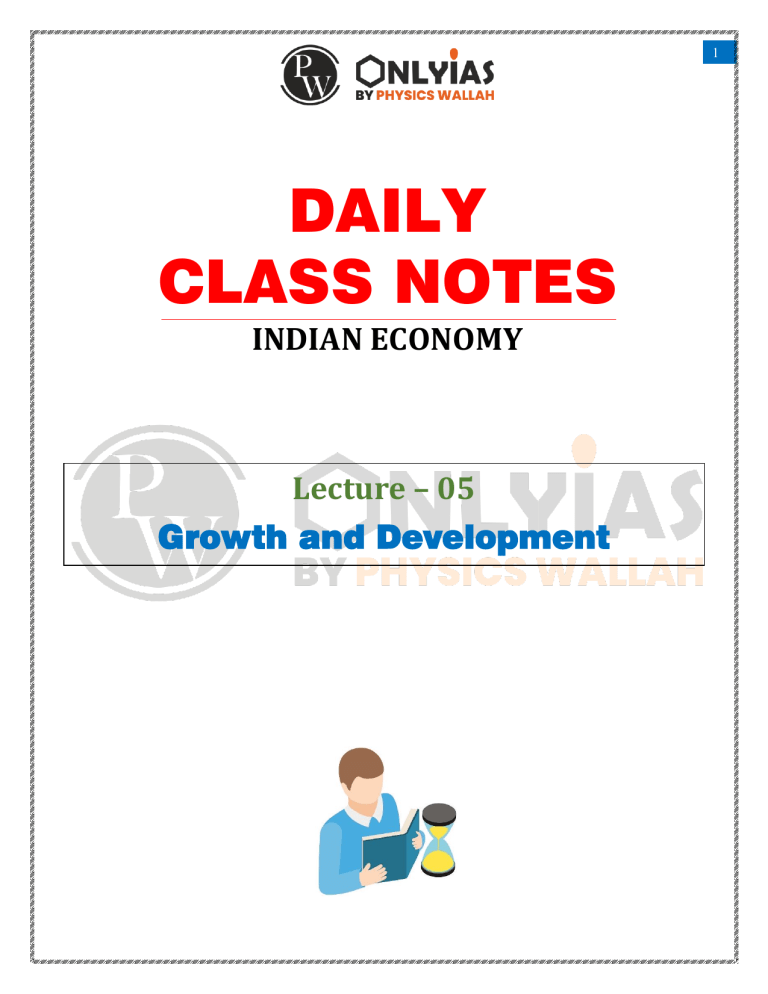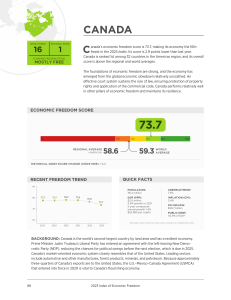
1 DAILY CLASS NOTES INDIAN ECONOMY Lecture – 05 Growth and Development 2 Growth and Development Problem with the Concept of GDP: ❖ GDP is not a measure of the overall quality of living or well-being of a country. ❖ GDP counts good as well as bad. When an earthquake hits and requires rebuilding, GDP increases. When someone gets sick and money is spent on their care, it is counted as a part of the GDP. But nobody would agree that we are better off because of destructive earthquakes or people getting sick. ❖ GDP is not adjusted for pollution cost. If the two economies have the same GDP per capita but one has polluted air and water while the other does not, well-being will be different but GDP per capita will not capture it. ❖ GDP is not telling what's all happening with the citizens of the country. ❖ GDP is not providing any information about environmental degradation and resource depletion. ❖ GDP tells hardly anything about sustainability. ❖ The quality of life may also depend upon the distribution of GDP among the residents of a country, not just the overall level. Growth and Development: 3 India’s Rank in Certain Indexes at Global Level: ❖ ❖ ❖ ❖ World Happiness Report, 2023: ➢ The World Happiness Report is an annual publication of the United Nations Sustainable Development Solutions Network. ➢ It contains articles, and rankings of national happiness based on respondent ratings of their own lives, which the report also correlates with various life factors. ➢ The ranking uses six key factors to measure happiness: social support, income, health, freedom, generosity, and absence of corruption. ➢ Top Performers: Finland has been crowned as the happiest nation, Denmark is at number two, followed by Iceland at number three. ➢ Worst Performers: Afghanistan was ranked as the unhappiest nation, followed by Lebanon, Sierra Leone, Zimbabwe, respectively. ➢ India ranks at 126th position out of 136 countries, making it one of the least happy countries in the world. ➢ In 2022, India ranked 136th position out of 146 countries. ➢ It even lags behind its neighboring nations like Nepal, China, Bangladesh and Sri Lanka. Social Progress Index, 2022: ➢ The Social Progress Index (SPI) measures the extent to which countries provide for the social and environmental needs of their citizens. ➢ Fifty-One indicators in the areas of basic human needs, foundations of well-being, and opportunity to progress show the relative performance of nations. ➢ The index is published by the nonprofit Social Progress Imperative, and is based on the writings of Amartya Sen, Douglass North, and Joseph Stiglitz. ➢ India's rank is 117 (it was 102 in 2019) with low social progress with a score of 56.8/100 in 2020. ➢ In 2022, India's rank is 110 and the score is 60.19. Legatum Prosperity Index, 2021: ➢ The Legatum Prosperity Index is an annual ranking developed by the Legatum Institute, a division of the private investment firm Legatum. ➢ The ranking is based on a variety of factors including wealth, economic growth, education, health, personal well-being, and quality of life. ➢ India ranked 101st out of 167 countries (Last Year India ranked 101) (in safety and Security 139th Place, Natural Environment- 160th, Personal freedom 106th, but yes when it comes to Enterprise Condition, we are at 51st Place). Global Hunger Index, 2022: ➢ Global Hunger Index developed by the International Food Policy Research Institute (IFPRI). ➢ India ranks 107th out of 121 countries in the Global Hunger Index, 2022 rankings with a score of 29.1. 4 ❖ ❖ ❖ ➢ Values from 0 to 9.9 reflect low hunger, values from 10.0 to 19.9 reflect moderate hunger, values from 20.0 to 34.9 indicate serious hunger, values from 35.0 to 49.9 reflect alarming hunger, and values of 50.0 or more reflect extremely alarming hunger levels. ➢ India is ranked behind most of its neighboring countries. Their ranks are given below: Pakistan - 99, Sri Lanka - 64, Nepal - 81, Bangladesh - 84. Human Development Index (HDI), 2021-22: ➢ The Human Development Index (HDI) is a composite index that is used to rank countries in terms of Human Development. ➢ It is published by the Human Development Report Office for the United Nations Development Programme (UNDP). ➢ A country scores a higher HDI when the lifespan is higher, the education level is higher, and the gross national income GNI (PPP) per capita is higher. ➢ It was developed by Pakistani economist Mahbub ul Haq, with help from Gustav Ranis of Yale University and Meghnad Desai of the London School of Economics. ➢ It is calculated using four indicators — life expectancy at birth, mean years of schooling, expected years of schooling, and the Gross National Income (GNI) per capita. ➢ The index rates countries on a scale of 0 to 1, with countries with a higher rating being more developed (in terms of human development) than countries with a lower rating. Therefore, the closer a score is to one, the greater the level of human development. ➢ India ranked 132nd among 191 countries and territories on the 2021 Human Development Index (HDI). ➢ India’s latest HDI value of 0.633 places the country in the medium human development category, lower than its value of 0.645 in the 2020 report. ➢ Among India’s neighbors, Sri Lanka (73rd), China (79th), Bangladesh (129th), and Bhutan (127th) are ranked above India, while Pakistan (161st ), Nepal (143rd ), and Myanmar (149th) are worse off. Corruption Perceptions Index, 2021: ➢ The Corruption Perceptions Index (CPI) is an index published annually by Berlin-based Transparency International since 1995 which ranks countries "by their perceived levels of public sector corruption, as determined by expert assessments and opinion surveys. ➢ If the score is 99-50, then the country is perceived as less corrupt, and 49-0, the country is perceived as more corrupt. ➢ Out of 179 countries, India is in 86th place with a score of 40 in 2020. India's score was 36 in 2012. In 2021, the rank is 85 and the score is 40. ➢ This year top countries are Denmark, New Zealand and Finland each with a score of 88. ➢ South Sudan, Syria and Somalia remain at the bottom of the index. Global Peace Index, 2021: ➢ Global Peace Index (GPI) is a report produced by the Institute for Economics & Peace (IEP) that measures the relative position of nations' and regions' peacefulness. 5 ❖ ➢ The GPI ranks 172 independent states and territories (collectively accounting for 99.7 per cent of the world's population) according to their levels of peacefulness. ➢ India's rank is 135 out of 163 nations in 2021. India's rank was 141 out of 171 countries in 2019. ➢ The 2021 GPI indicates Iceland, New Zealand, Denmark, Portugal, Austria, Slovenia, and Denmark to be the most peaceful countries, and Afghanistan, Syria, Iraq, South Sudan, and Yemen to be the least peaceful. Global Terrorism Index, 2023: ➢ The Global Terrorism Index (GTI) is a report published annually by the Institute for Economics and Peace (IEP), and was developed by IT entrepreneur and IEP's founder Steve Killelea.. ➢ The index provides a comprehensive summary of the key global trends and patterns in terrorism since 2000. ➢ The GTI is based on data from the Global Terrorism Database (GTD) which is collected and collated by the National Consortium for the Study of Terrorism and Responses to Terrorism (START) at the University of Maryland. ➢ The GTD has codified over 190,000 cases of terrorism, it covers 163 countries, consisting 99.7% of the world's population. ➢ If the score is 10-8 (Very high impact), 8-6 (High impact), 6-4 (Medium impact), 4-2 (Low impact), 2-0 (Very low impact), and 0 (No impact). ➢ India ranks 13 in this index with a score of 7.353. Some Other Facts: ❖ ❖ Prevalence of Undernourishment: ➢ According to Global Hunger Index, 2022, prevalence of undernourishment, which is a measure of the proportion of the population facing chronic deficiency of dietary. energy intake, has risen in the country from 14.6% in 2018-2020 to 16.3% in 2019-2021. ➢ This translates into 224.3 million people in India considered undernourished out of the total 828 million people undernourished globally. Deaths due to Air Pollution: ➢ Pollution led to more than 2.3 million premature deaths in India in 2019, according to a new Lancet study published in May, 2022. ➢ Nearly 1.6 million deaths were due to air pollution alone, and more than 500,000 were caused by water pollution. ➢ The study found that more than 90% of pollution related deaths occurred in low-income and middleincome countries, with India topping the list with 2.36 million and China at number two with 2.1 million deaths.




